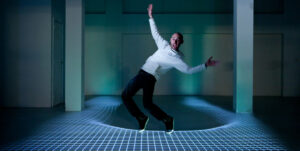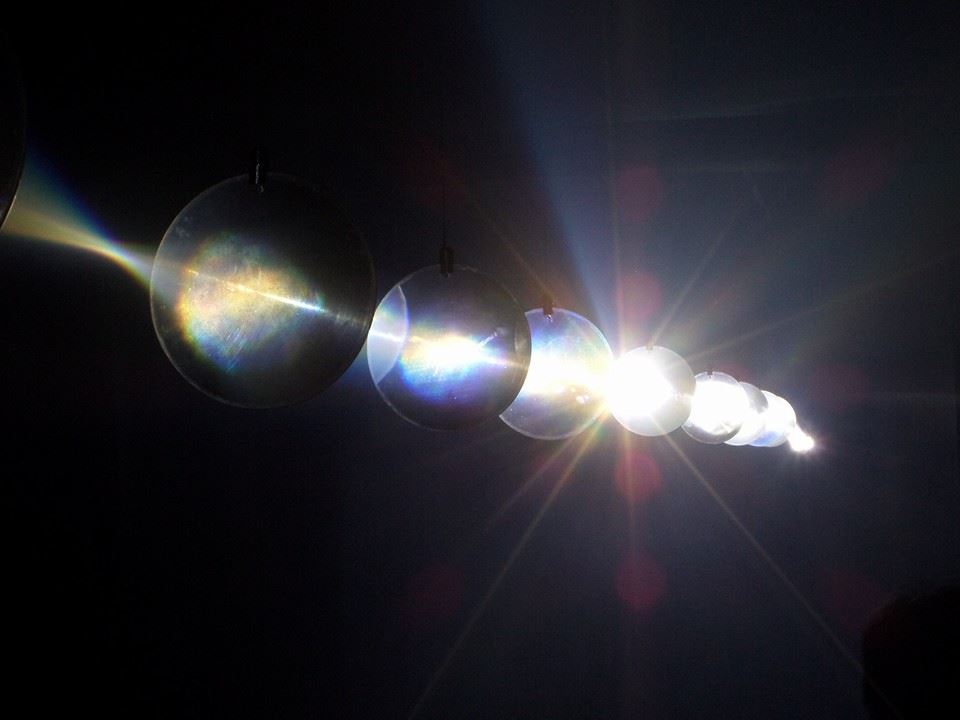
The exhibition is dedicated to video art, with a particular focus on mapping, and how this practice approaches the notion of territory. Sensitive cartography, material and immaterial, generative and narrative images, the combination of data and emotions to interpret information or a situation, digital creations transcend the languages of the visual arts, between real vision and imaginary projection, between geographical spaces and mental space.
Here, we propose to explore these different territories, whether physical and tangible (projections that deceive and transform our perception of space), imaginary (mental and subjective representations), or dematerialized (flows and networks).
Interactivity, A/V installations, collaborative netart, video mapping and Datavis are likely to represent the emerging forms of a new artistic language. The exhibition will put these different practices and the impact of digital technology on the visual arts into perspective.
Daniel Canogar (ES) – Scanner Installation video mapping
Mixed electrical, telephone and computer cables form a canvas-like sculpture. White lines are projected onto the cables, giving the twisted mass a powerful effect of light sparking through the cables. As the passage of light through the installation shows, parallels are drawn between the human circulatory system and the energy that drives our information society.
Gaëtan Robillart (FR) – En recherchant la vague, HD video projection, sound, polystyrene sculptures, embossed paper, programming
Inspired in the first instance by Courbet’s waves, this work explores the passage of nature into a mathematical space, while at the same time focusing on the synthesis of movement. The animation is part of an installation that integrates polystyrene sculptures, embossed drawings and lighting. The course of the film follows a journey along the shore of an island from which the camera seeks to escape. A voice-over tells a story built around a mathematical equation specially chosen for its description of the wave phenomenon.
Candas Sisman (TR) – IPOcle Light installation
IPOcle is an installation simulating the way we perceive the reality that exists in our physical world and the different layers, variables and cycles that are present in this process of perception. Our senses allow us to perceive only a limited part of the physical reality that surrounds us. This perception is altered by numerous biological and psychological layers and processes in our brains. These perceptions are based on our perceptual patterns and these patterns, in turn, shape the reality we perceive. At this point, how can we define reality?
https://csismn.com/I-P-O-cle
Mark Fell (UK) – Centrality, Rotation, Convolution Laser and mirror installation
Mark Fell’s installation uses motor-driven, computer-controlled lasers to distribute light beams around a floor space, creating kaleidoscopic geometric patterns. The work’s two basic forms – the line and the circle – are common to a number of Fell’s recent works.
In the installation presented at E-FEST, tones, colors, shapes and movement are brought together in unusual variations and relationships. While light takes the form of a line, the sound component of the work is derived from Shepard’s scale, based on the description of sound as a helical or cyclical curve. Fell’s interest in this line and circle stems in part from research carried out by anthropologist Warren D. Tenhouten, who suggests two distinct f o rms of temporal consciousness: cyclically structured consciousness and ordinary linear consciousness. By bringing these components together, Fell seeks to examine how these impressions of space and time are constructed.
https://markfell.com/web/selected-works
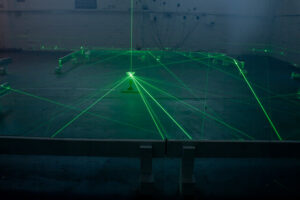
Arthur Zerktouni (MA/FR)- She’s used to Water and video installation
Projected onto three water columns, black-and-white videos of young women appear as faded holograms. Memories of a present that doesn’t exist, nostalgia for an uncertain future, this installation, bathed in a slowed-down soundtrack, bears witness to a time from which the actresses cannot escape, to the artist’s doubts and his fear of a habit that won’t go away. Arthur Zerktouni’s installations offer a sensitive aesthetic experience characterized by a dematerialization of time and matter. He provokes our senses to create a universe of impressions.
Scénocosme (FR) – Métamorphy Interactive visual and sound installation
Métamorphy offers forms of immersion and possible projections of the body, combining real and imaginary reflections. This creation offers a dreamlike journey through sensory interactions with a sensory veil. Each touch of the hand reveals different depths. Exploring its different layers in depth reveals the intimacy of an imaginary universe. Visual and sound materials evoke deep, meditative worlds, through organic, liquid or incandescent substances.
Ali Tnani (TU) – Data Trails Installation Netart
Data Trails is a computer program that has been under development for the past year. This prototype was the cornerstone of two new media installations: Crackling Data Machine & Data, Dust, for which it sucks information from certain websites. Dependent on an Internet connection, it operates in real time. The choice of sources is not arbitrary, but questions a certain practice of the Semantic Web: content curation. What subversion can we detect in this utopian production of knowledge? The display approaches a form where data is not replaced by other data. Their imprint remains with the new content, and words condense like airplane trails in the sky. Data Trails refers to generative literature, questioning the laws of probability, a certain « state of the sky » and the place of their confluence.
Ali Tnani was born in Tunis in 1982. He lives and works in France. A 2007 graduate of the Institut Supérieur des Beaux-arts de Tunis, he was resident at Transcultures in Mons, Belgium, in 2010, then at the Cité Internationale des Arts in Paris in 2011-2012.
https://alitnani.com/Data-trails
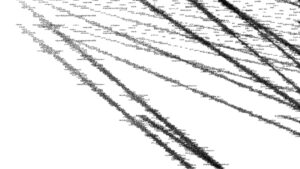
Haythem Zakaria (TU) – Triptych #2 // Alif Tubular point and Indian ink, 65*300 cm
Born in Tunis in 1983, Haythem Zakaria explores ways of augmenting the image by incorporating, grafting or superimposing visual or sound indications, thus probing visual creation by working on the proliferation of the image and its regeneration into visual partitions. More recently, Haythem Zakaria has begun a series of works focusing on the letter alif, the first letter of the Arabic alphabet, and its hidden meaning. From this double questioning was born in 2014 the « Alif » project: a series of drawings made with Indian ink on paper and representing a succession of parallel ordered and connected lines. Connected and hidden are perhaps the two words that would best describe the works of this digital artist, whose preoccupations oscillate between the need to create interaction with another and the need to invite that other to deepen his connection with his inner self. Formally simple, the meaning of the works on view is never obvious. Removed from immediacy, it reveals itself to those who patiently take the time.
www.haythemzakaria.com/
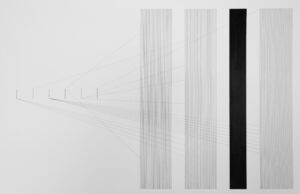
Fabio Perletta & Giustino Di Gregorio (IT) – Trapped Light Video installation
Trapped Light is an immersion in memory. A child tries to catch a beam of light. This ephemeral image is a slow, imperfect breath, with fragile contours. Monochromatic geometries and vibrations of light shrink space-time in an endless loop. A cylindrical cage and a trapped flow of energy reveal the memory and purity of a free, ephemeral act.
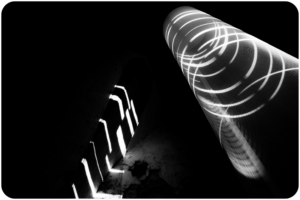
Farah Khelil (TU) – Figures sagittales, 2014 Installation Datavis
Légendes (2012) is a selection of captioned plates of equipment illustrations, selected from visual dictionaries and stripped of their figures. These prominent captions detach the technical object and redraw its contours through reading. They reveal the internal and external components of technical objects and devices. Technique mixte (2014) completes the picture through a data mining process, graphically translating statistical results that evolve according to the occurrences of the captions provided in the database, presenting a dynamic profile and visualization of technical objects.
Farah was born in Carthage in 1980. She lives and works between Paris and Tunis. A multimedia artist with a degree from the Beaux-arts de Tunis, Farah Khelil is currently pursuing a doctorate in Arts and Art Sciences and teaches at Paris I Panthéon-Sorbonne.
http://farahkhelil.free.fr/
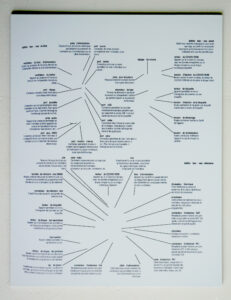
Visualizing Impact (LBN)- Data Visualisation
Based in Beirut, VISUALIZING IMPACT (VIM) is an innovation laboratory at the intersection of data science, technology and design. VIM creates powerful tools to highlight critical social issues around the world. Its Mission: to innovate in citizen data science, technology and design, and to integrate the marginalized and perspectives on critical social issues.
For the MAPP’ ing exhibition, VIM will present visuals that deal with global issues, today’s societies and inequalities between populations, and more specifically a focus on Palestine, the Palestinian-Israeli conflict, but also
https://visualizingpalestine.org/
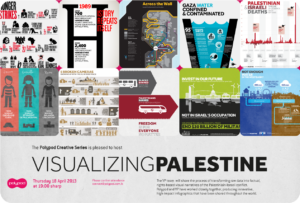
H & N (TU/BEL) – The Border Game Video installation
Composed of artists Hejer Chelbi and Nicolas Pfeiffer, H&N explores the relationship between art, public space and societies. Their research aims to create interactive installations of reflective and sensitive images and spaces.
Taking the form of a border that the viewer must cross, « The Border Game » explores notions of territory and media space, a point of view on the world around us, divided, torn and deconstructed. From television zapping to international news channels, the work takes viewers on a journey here and elsewhere, a journey in time around what’s happening in the world. Materialising the path of a cone of light, that of the projector, the installation invites the viewer to cross it, thus voluntarily or involuntarily seeking to force visitors to alter the image through their shadow in the succession of strata. The image first projected in two dimensions then propagates into the third, creating a new image, a new depth.
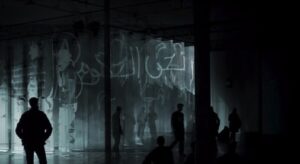
Mike Latona & Jozef De Leeuw (BEL) – Origapping Paper installation and video mapping
MATHEMATICS, GEOMETRY, REPETITION, MOVEMENT. Origami as a support for mapping. Six rectangles of paper… Just folding, to give birth to shapes. Light to give life…
Mike Latona, known by his artist name ‘Los Hermanos’, has been an active visual artist for thirteen years. Trained as a VJ, mapper, painter and graphic designer, he thrives on street art. Fascinated by both urban visuals and scenography, he works to integrate art into reality and help people discover the many possibilities of mapping.
